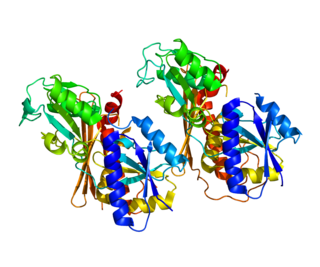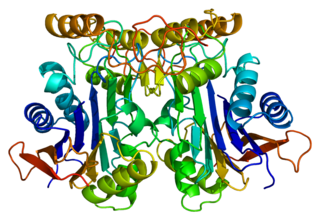Related Research Articles

Krabbe disease (KD) is a rare and often fatal lysosomal storage disease that results in progressive damage to the nervous system. KD involves dysfunctional metabolism of sphingolipids and is inherited in an autosomal recessive pattern. The disease is named after the Danish neurologist Knud Krabbe (1885–1961).

Leukodystrophies are a group of, usually, inherited disorders, characterized by degeneration of the white matter in the brain. The word leukodystrophy comes from the Greek roots leuko, "white", dys, "abnormal" and troph, "growth". The leukodystrophies are caused by imperfect growth or development of the glial cells which produce the myelin sheath, the fatty insulating covering around nerve fibers. Leukodystrophies may be classified as hypomyelinating or demyelinating diseases, respectively, depending on whether the damage is present before birth or occurs after. Other demyelinating diseases are usually not congenital and have a toxic or autoimmune cause.

Porphobilinogen deaminase (hydroxymethylbilane synthase, or uroporphyrinogen I synthase) is an enzyme (EC 2.5.1.61) that in humans is encoded by the HMBS gene. Porphobilinogen deaminase is involved in the third step of the heme biosynthetic pathway. It catalyzes the head to tail condensation of four porphobilinogen molecules into the linear hydroxymethylbilane while releasing four ammonia molecules:

Arylsulfatase A is an enzyme that breaks down sulfatides, namely cerebroside 3-sulfate into cerebroside and sulfate. In humans, arylsulfatase A is encoded by the ARSA gene.

Paired-like homeobox 2b (PHOX2B), also known as neuroblastoma Phox (NBPhox), is a protein that in humans is encoded by the PHOX2B gene located on chromosome 4.

N(4)-(beta-N-acetylglucosaminyl)-L-asparaginase is an enzyme that in humans is encoded by the AGA gene.

Inositol polyphosphate 5-phosphatase OCRL-1, also known as Lowe oculocerebrorenal syndrome protein, is an enzyme encoded by the OCRL gene located on the X chromosome in humans.

The CLCN family of voltage-dependent chloride channel genes comprises nine members which demonstrate quite diverse functional characteristics while sharing significant sequence homology. The protein encoded by this gene regulates the electric excitability of the skeletal muscle membrane. Mutations in this gene cause two forms of inherited human muscle disorders: recessive generalized myotonia congenita (Becker) and dominant myotonia (Thomsen).

Transforming growth factor, beta-induced, 68kDa, also known as TGFBI, is a protein which in humans is encoded by the TGFBI gene, locus 5q31.

Protein patched homolog 1 is a protein that is the member of the patched family and in humans is encoded by the PTCH1 gene.

Exostosin-1 is a protein that in humans is encoded by the EXT1 gene.

Myotubularin is a protein that in humans is encoded by the MTM1 gene.

Eyes absent homolog 1 is a protein that in humans is encoded by the EYA1 gene.

Beta-sarcoglycan is a protein that in humans is encoded by the SGCB gene.

Membrane protein MLC1 is a protein that in humans is encoded by the MLC1 gene.

Ceroid-lipofuscinosis neuronal protein 5 is a protein that in humans is encoded by the CLN5 gene.

Y+L amino acid transporter 1 is a protein that in humans is encoded by the SLC7A7 gene.

Meckel syndrome, type 1 also known as MKS1 is a protein that in humans is encoded by the MKS1 gene.

Gap junction gamma-2 (GJC2), also known as connexin-46.6 (Cx46.6) and connexin-47 (Cx47) and gap junction alpha-12 (GJA12), is a protein that in humans is encoded by the GJC2 gene.
In molecular biology, glycoside hydrolase family 59 is a family of glycoside hydrolases.
References
- 1 2 3 "Entrez Gene: galactosylceramidase".
- ↑ Lee WC, Tsoi YK, Troendle FJ, et al. (August 2007). "Single-dose intracerebroventricular administration of galactocerebrosidase improves survival in a mouse model of globoid cell leukodystrophy". FASEB J. 21 (10): 2520–2527. doi: 10.1096/fj.06-6169com . PMID 17403939. S2CID 19511563.
| GALC | |||||||||||||||||||||||||||||||||||||||||||||||||||
|---|---|---|---|---|---|---|---|---|---|---|---|---|---|---|---|---|---|---|---|---|---|---|---|---|---|---|---|---|---|---|---|---|---|---|---|---|---|---|---|---|---|---|---|---|---|---|---|---|---|---|---|
| Identifiers | |||||||||||||||||||||||||||||||||||||||||||||||||||
| Aliases | GALC , entrez:2581, galactosylceramidase | ||||||||||||||||||||||||||||||||||||||||||||||||||
| External IDs | OMIM: 606890 MGI: 95636 HomoloGene: 124 GeneCards: GALC | ||||||||||||||||||||||||||||||||||||||||||||||||||
| |||||||||||||||||||||||||||||||||||||||||||||||||||
| |||||||||||||||||||||||||||||||||||||||||||||||||||
| |||||||||||||||||||||||||||||||||||||||||||||||||||
| |||||||||||||||||||||||||||||||||||||||||||||||||||
| |||||||||||||||||||||||||||||||||||||||||||||||||||
| Wikidata | |||||||||||||||||||||||||||||||||||||||||||||||||||
| |||||||||||||||||||||||||||||||||||||||||||||||||||



